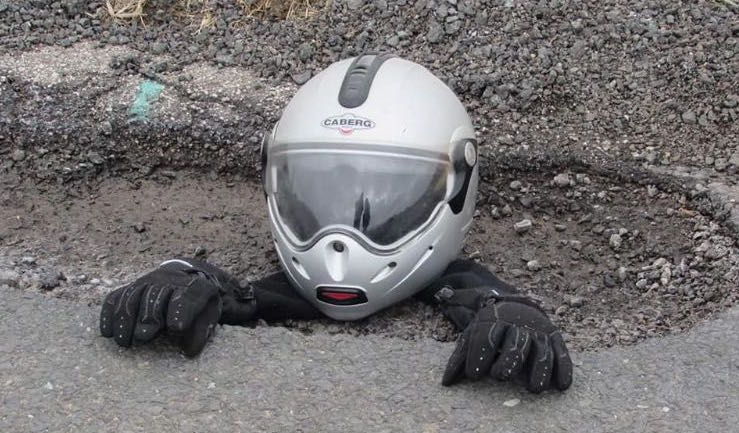Highways England repaired 22,862 potholes last year, up from 14,104 in 2017, and the compensation bill soared from £81,500 in 2017 to £329,379 in 2018.
The definition of a pothole varies depending on where you live.
Britain’s roads are maintained by a network of 207 local highways authorities (LHA), each with its own budget, problems and priorities, and each allowed to come up with its own set of rules that defines when a road defect becomes a pothole that needs fixing. And even once a pothole reaches that critical threshold there’s an equally diverse set of response times and reactions. The overall result is that a pothole that gets fixed within hours on one stretch of road might be left for much longer – or allowed to get worse – if it was just a few yards away, across the boundary into another LHA’s territory.
The vast variation between different areas is highlighted by a set of Freedom of Information (FoI) requests sent out by the RAC Foundation late last year. Of the 207 authorities, 190 provided enough data for the RAC Foundation to pull together a comprehensive comparison of the varying thresholds and response times around the country.
The results show that, encouragingly, most (75%) of the LHAs now adopt a ‘risk-based approach’ to fixing potholes. That means rather than ticking specific boxes about pothole dimensions before triggering a repair, LHAs assess the potential dangers, both to people and vehicles, and base their decisions to fix holes on those risks. However, most still have dimensional thresholds that the potholes must exceed before they even enter the risk-assessment phase, and there’s a wide disparity of those thresholds across the nation.
The RAC’s FoI revealed that in some parts of the country (12 LHAs) there’s no specific threshold, and any reported road damage will automatically be risk-assessed. In another 37 LHA, small potholes between 20mm to 30mm deep would get assessed, while at the other end of the scale there were 26 LHAs that won’t even initiated a risk-assessment, let alone a repair, until the hole is more than 50mm in depth. For car drivers, that could be the difference between an uncomfortable thump and a puncture or dented wheel rim. For motorcyclists the stakes are rather higher.
Even the chance of a pothole being recorded in the first place varies from place to place. Although there is a Code of Practice for LHAs that recommends checking primary and secondary roads once a month, link roads once every three months and local roads once a year, only 28% of LHAs actually follow that guidance. In all, the RAC Foundation discovered there are 109 different inspection frequencies used between the 190 authorities that responded to its investigation. As well as these inspections, authorities will also check on potholes reported by the public; so if you see or hit a pothole that looks like it poses a danger, it’s worth reporting it as it could be weeks or months before the next scheduled check on any particular piece of road.
Even once a pothole has reached the threshold of size required for a risk-assessment, there’s a wide variation in response times depending on the LHA area that it falls within and the results of that assessment. But even then, there’s still a broad spread of responses.
In some areas, potholes assessed to be in the worst category will be fixed ‘immediately’, with 8% aiming to be on the case within an hour for the most dangerous holes and 42% aiming at a two-hour limit. But here the postcode lottery for potholes is clear once again – in Harrow, for instance, the worst holes will be fixed within 30 minutes, while in Coventry the target time for fixing holes of the same class is five days.
Reactions to less severe potholes are similarly diverse, with 18% of LHAs aiming to fix the least-urgent ones within 28 days, while 25% will leave it until the next ‘programmed works’ on that stretch of road and 13% will simply monitor the hole, leaving repairs until it gets bad enough to slide into a riskier category.
Away from LHA roads, potholes are also an increasing problem on motorways and strategic roads operated nationwide by Highways England. A Freedom of Information inquiry in December revealed that Highways England repaired 22,862 potholes in 2018, up from 14,104 in 2017. It also showed that the amount of compensation paid following damage report claims rose spectacularly, from £81,500 in 2017 to £329,379.
The best motorcycle industry news at www.britishdealernews.co.uk

No comments:
Post a Comment